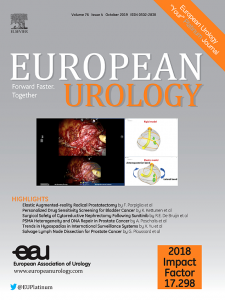Long-term Outcomes and Patterns of Relapse Following High-dose Elective Salvage Radiotherapy and Hormone Therapy in Oligorecurrent Pelvic Nodes in Prostate Cancer: OLIGOPELVIS (GETUG-P07)
IF 25.3
1区 医学
Q1 UROLOGY & NEPHROLOGY
引用次数: 0
Abstract
Background and Objective
Androgen deprivation therapy (ADT) is a mainstay in metastatic prostate cancer, while additional salvage radiotherapy may offer prolonged remission for patients with regional node relapses. We performed an open-label, phase II trial to assess the long-term outcomes and patterns of relapse of 6-months ADT and elective pelvic radiotherapy in men with oligorecurrent (<6) pelvic nodes in prostate cancer (Oligopelvis GETUG-P07).
Methods
We analyzed the 5-yr outcomes. Progression was defined as two consecutive prostate-specific antigen levels above the level at inclusion and/or clinical progression as per RECIST 1.1 and/or death from any cause.
Key Findings and Limitations
Sixty-seven patients were recruited. The median follow-up was 6.1 yr (95%CI: 5.9-6.3). Grade 2+ 3-yr, 4-yr and 5-yr genito-urinary and gastro-intestinal toxicities affected 15%, 9%, 4% and 2%, 3%, 4% of non-progressive patients, respectively. 5-yr progression-free, biochemical relapse–free and ADT-free survivals were 39%, 31% and 64%, respectively. In total, 45 patients had progression and 38 had the following clinical progression: local (18%), N1 (29%), M1a (50%), M1b (32%) and M1c (11%).
Conclusions and Clinical Implications
Finally, combined elective pelvic radiotherapy and ADT appeared to prolong tumor control with limited toxicity. At 5 years, one third of patients had not relapsed biochemically. The major site of relapse was para-aortic lymph nodes.
前列腺癌低位盆腔结节患者接受大剂量选择性挽救放疗和激素治疗后的长期疗效和复发模式:oligopelvis(GEUG-P07)。
雄激素剥夺疗法(ADT)是治疗转移性前列腺癌的主要方法,而额外的挽救性放疗可以延长区域结节复发患者的缓解期。我们报告了OLIGOPELVIS (GETUG-P07)的5年疗效,这是一项开放标签的2期试验,评估了盆腔结节少复发男性患者在接受6个月ADT和选择性结节放疗(ENRT)后的长期疗效和复发模式。
本文章由计算机程序翻译,如有差异,请以英文原文为准。
求助全文
约1分钟内获得全文
求助全文
来源期刊

European urology
医学-泌尿学与肾脏学
CiteScore
43.00
自引率
2.60%
发文量
1753
审稿时长
23 days
期刊介绍:
European Urology is a peer-reviewed journal that publishes original articles and reviews on a broad spectrum of urological issues. Covering topics such as oncology, impotence, infertility, pediatrics, lithiasis and endourology, the journal also highlights recent advances in techniques, instrumentation, surgery, and pediatric urology. This comprehensive approach provides readers with an in-depth guide to international developments in urology.
 求助内容:
求助内容: 应助结果提醒方式:
应助结果提醒方式:


